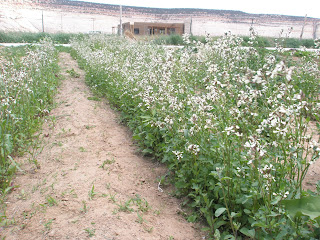Hey everyone,
The last 10 days have flown by, and we neglected to realize we hadn't posted in a while. We wanted to take the time to focus on some of the farming details, and not just highlight the spectacular scenery. Here are some of the things we've noticed and learned while working for HBG's farm.
Heirloom vegetables: The farm uses more varieties of vegetables such as lettuce, tomatoes, carrots, and beets than I knew existed. A focus on heirloom varieties such as true gold corn and Amish paste tomatoes widens the selection available for the restaurant and gives customers a memorable dining experience. Using heirlooms also helps keeps these delicious varieties from being forgotten amidst the more popular grocery store selections. The farm also uses crops appropriate for the dry, windy climate in very creative ways; wildflowers become garnish, tumbleweeds, arugula, and lamb's quarters are included in salads and appetizers.
Three Sisters Garden: One of the beds on the farm is planted using the three sisters technique. This follows Native American farming practices; corn provides a stalk for the beans to grow on, the beans provide Nitrogen for the soil, and squash functions as ground cover to prevent weeds and erosion. We planted and weeded just less than an acre in the first week on the farm.
Companion planting: Companion planting is the planting of different crops in proximity (in gardening and agriculture), on the theory that they assist each other in nutrient uptake, pest control, pollination, and other factors necessary to increasing crop productivity.
Climate Control
Hoophouse: A long, narrow tunnel made using flexible tubing covered in plastic sheeting. The sheeting traps radiation, raising the temperature in the hoop house to increase productivity from the plants. The farm uses the hoop house to grow tomatoes and cucumbers. One advantage to these is that it gives plants a jump start: a farmer can get tomatoes and other heat loving vegetables before they would be ready otherwise. You can also grow cold tolerant plants after the weather cools and frosts begin to set in.
Greenhouse: Green houses are another means of combating cold weather. The farm built a straw bale green house. They used reclaimed wood to make them frame, then made the walls from straw bales covered in cob (a mixture of clay and more straw). This is great for insulation--perfect for a green house! The farm uses their green house to start transplants for planting once the weather warms as you can see below.
Milk Jug Greenhouses:
Sometimes when plants need to get into the beds before the weather has stabilized enough the farm uses milk jugs as mini green houses. These are great when there is still a chance of frosts and raiding the recycling bins provides a great free source.
Cold Frames: The cold frames have osaka purple mustard and red Russian kale. These are cold hardy plants so they can be planted early in the season. The cold frames raise them above the ground to keep them warm and have a glass topper to make use of the green house effect.
Mounding: HBG's farm uses mounds for potatoes, squash, and cucumbers. This helps for drainage. Mounding potatoes also lets you continue to bury them to increase the root structure and produce more potatoes.
The rest of the pictures are taken of the area around the farm and of the farm's pond. Boulder finally got a good rainstorm. The clouds over the mountains were awesome and we were lucky enough to see a huge rainbow arching across Sugarloaf mountain. The pond in the picture is on the farm. It's used not only for irrigation, but to cool off after a warm day on the farm. Because Chris and I only have access to showers on Wednesdays and Sundays, we have jumped in to wash off at the end of many days here in Boulder.
Wednesday, June 16, 2010
Farming at Blaker's Acres (Boulder, UT)
Posted by Carrie Burns at 2:15 PM
Subscribe to:
Post Comments (Atom)













0 comments:
Post a Comment